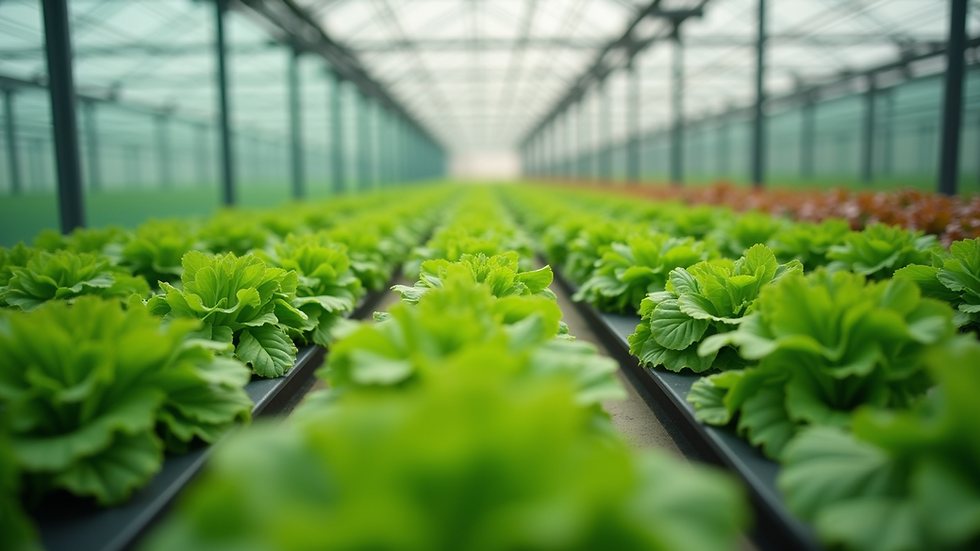How Hydroponic Systems Are Shaping Modern Agriculture
- Matthew Bowser
- Sep 16
- 4 min read
Modern agriculture is undergoing a significant transformation, driven by innovative technologies that aim to increase efficiency, sustainability, and productivity. Among these innovations, hydroponic systems stand out as a revolutionary approach to growing plants without soil. This method uses nutrient-rich water solutions to cultivate crops, offering numerous advantages over traditional farming. In this article, we will explore how hydroponic systems are reshaping agriculture, their benefits, challenges, and practical applications.
Understanding Hydroponic Systems and Their Role in Agriculture
Hydroponic systems are a method of growing plants using mineral nutrient solutions in water, without soil. This technique allows plants to grow faster and healthier by providing direct access to essential nutrients. There are several types of hydroponic systems, including:
Nutrient Film Technique (NFT): A thin film of nutrient solution flows over the roots.
Deep Water Culture (DWC): Plants are suspended in oxygenated nutrient-rich water.
Aeroponics: Roots are misted with nutrient solution in the air.
Ebb and Flow: Nutrient solution floods the plant roots periodically and then drains away.
Each system has its unique advantages and is chosen based on the crop type, space availability, and resource constraints.
Hydroponic systems enable year-round crop production, independent of soil quality or climate conditions. This makes them especially valuable in urban areas or regions with poor soil fertility. Additionally, hydroponics uses significantly less water than traditional farming, making it a sustainable option in water-scarce areas.

Hydroponic lettuce thriving in a nutrient-rich water solution
Benefits of Hydroponic Systems in Modern Agriculture
Hydroponic systems offer several compelling benefits that are driving their adoption worldwide:
1. Increased Crop Yield and Faster Growth
Plants grown hydroponically often grow 25-50% faster than those grown in soil. This is because nutrients are delivered directly to the roots in an easily absorbable form. The controlled environment also reduces stress factors like pests and diseases.
2. Efficient Use of Water and Nutrients
Hydroponics uses up to 90% less water than traditional soil farming. The closed-loop systems recycle water and nutrients, minimizing waste. This efficiency is crucial in areas facing water shortages.
3. Space Optimization
Hydroponic systems can be stacked vertically, allowing farmers to maximize production in limited spaces. This is ideal for urban farming and indoor agriculture, where land is scarce and expensive.
4. Reduced Use of Pesticides and Herbicides
Since hydroponic systems are often operated in controlled environments, the risk of pests and diseases is lower. This reduces the need for chemical pesticides, leading to cleaner and safer produce.
5. Year-Round Production
Hydroponic farms can operate indoors or in greenhouses, enabling continuous crop production regardless of seasonal changes. This ensures a steady supply of fresh produce throughout the year.

Vertical hydroponic farm maximizing space for leafy green production
Practical Applications and Examples of Hydroponic Systems
Hydroponic systems are being used in various agricultural sectors, from small-scale home gardens to large commercial farms. Here are some practical examples:
Urban Farming and Community Gardens
In cities, hydroponic systems allow residents to grow fresh vegetables in apartments, rooftops, or community spaces. This reduces food miles and promotes local food security.
Commercial Greenhouses
Large-scale hydroponic greenhouses produce high-value crops like tomatoes, cucumbers, and herbs. These farms use automated systems to monitor nutrient levels, temperature, and humidity, optimizing growth conditions.
Educational and Research Institutions
Hydroponics is widely used in schools and universities to teach sustainable agriculture practices. Research institutions also use these systems to study plant nutrition and develop new crop varieties.
Space Exploration
NASA has experimented with hydroponic systems to grow food in space. This technology could support long-term space missions by providing astronauts with fresh produce.
For those interested in learning more about the impact and techniques of hydroponics in agriculture, there are many resources and case studies available online.
Challenges and Considerations When Implementing Hydroponic Systems
Despite their many advantages, hydroponic systems also come with challenges that must be addressed for successful implementation:
Initial Setup Costs
Hydroponic farms require investment in equipment such as pumps, grow lights, and nutrient delivery systems. While operational costs can be lower, the upfront expenses may be a barrier for some farmers.
Technical Knowledge and Management
Managing a hydroponic system requires understanding plant nutrition, water chemistry, and system maintenance. Training and expertise are essential to avoid issues like nutrient imbalances or system failures.
Energy Consumption
Indoor hydroponic farms often rely on artificial lighting and climate control, which can increase energy use. Integrating renewable energy sources can help mitigate this impact.
Disease Management
While soil-borne diseases are less common, waterborne pathogens can spread quickly in hydroponic systems. Regular monitoring and sanitation are critical to prevent outbreaks.
Crop Selection
Not all crops are suitable for hydroponic cultivation. Leafy greens, herbs, and some fruits like strawberries perform well, but root vegetables and large fruiting plants may be more challenging.

Close monitoring of nutrient solution flow is essential in hydroponic systems
The Future of Agriculture with Hydroponic Systems
Hydroponic systems are poised to play a vital role in the future of agriculture. As the global population grows and arable land becomes scarcer, sustainable and efficient farming methods will be crucial. Hydroponics offers a way to produce more food with fewer resources, reducing environmental impact.
Advancements in technology, such as automation, artificial intelligence, and improved sensors, will make hydroponic farming more accessible and efficient. Integration with renewable energy and smart water management will further enhance sustainability.
Farmers, entrepreneurs, and policymakers should consider investing in hydroponic systems to build resilient food systems. By embracing this innovative approach, we can ensure food security, reduce waste, and protect natural resources for future generations.
Hydroponic systems are transforming agriculture by offering a sustainable, efficient, and scalable way to grow crops. Whether in urban settings, commercial farms, or research labs, hydroponics is proving to be a game-changer. With continued innovation and adoption, these systems will help meet the growing demand for fresh, nutritious food while preserving the planet's resources.






Comments